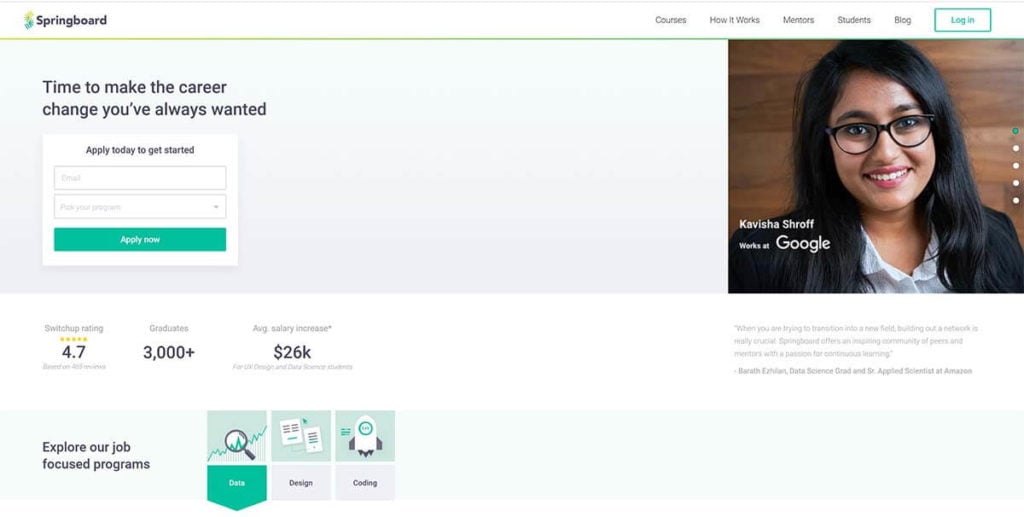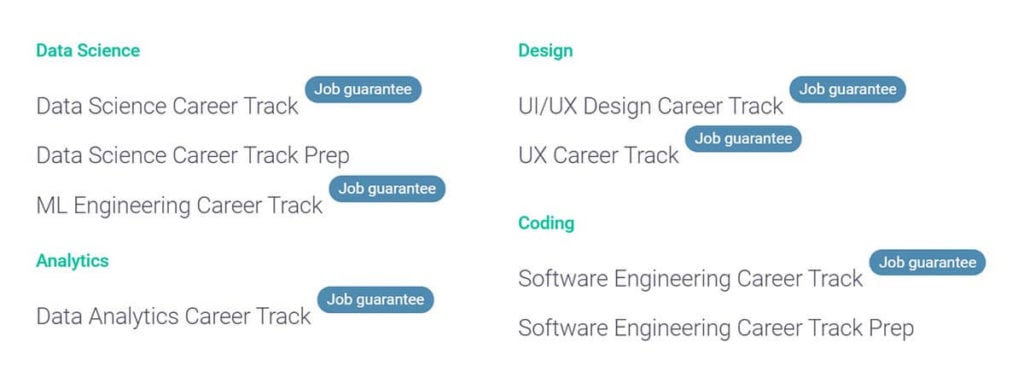Table of Contents
Springboard is an online course website with a rather unique twist. All qualifying graduates get a job in their field in six months, guaranteed. If they don’t, they are entitled to a full refund from Springboard. Add expert mentors and high-quality curricula into the mix, and you get a pretty sweet deal. However, that’s not all there is to the site.
During this Springboard review, I will dig deep into the site to find and analyze all the quirks and features I can find. Let’s get right into it.
What is Springboard?

Springboard is an online education provider that focuses on career-building through so-called “Career Tracks”. While their service is comparable to other online course platforms such as edX and Coursera, it’s important to note that there are some key differences that set them apart from all other MOOC providers.
The most important aspect to note is that no other online learning provider besides Springboard actually offers definite job opportunities for all graduates. Through partnerships with major corporations, Springboard has managed to guarantee job offers for all qualifying graduates, which is unheard of in the online learning industry.
All of Springboard’s online courses help thee students in career-building. Either by adding new material to your CV or by training new skills, job-seeking is always on the forefront. However, Springboard goes a step forward, or perhaps even a great leap forward, by guaranteeing an actual job offer after graduation to all Career Track students. And, not only that, but they offer full refunds to students who can’t land a job.
Springboard is a totally unique MOOC provider in this regard, and it feels like a breath of fresh air in the otherwise uninspired e-learning industry that tends to be full of copycats.
Now, let’s dig deeper into my review of Springboard to find out about how the platform operates and who it’s best suited for.
How Springboard Works
The working process of Springboard’s online courses involves the following 10 steps:
- Students choose an online course and start the admissions process*
- Admitted students are matched with mentors
- The online curriculum is carried out with the students
- Students develop small and large-scale capstone projects
- Mentors provide feedback to the student projects
- Students and mentors review weekly learning goals
- The final project is carried out
- Graduation and certification
- Students start the job-searching process
- If students don’t land a job within 6 months, they are entitled to a full refund

Who is Springboard For?
Springboard is an online course platform best suited for students from the United States, Canada or India and who are interested in STEM subjects. The first statement might appear strange at first, as MOOCs are supposed to be global and not limited by geographical locations. However, when it comes to Springboard’s Career Tracks, they only guarantee a job offer to those graduates who have the legal rights to work in the United States or Canada. This might change in the future, but as of the writing of this review, from what I understood only students that are from these countries are eligible for the guaranteed job offers.
Now, to clarify the statement regarding Springboard being best suited for STEM students, it’s important to note that the platform currently only has six courses to offer. As Springboard almost exclusively focuses on data science and programming, many students will find that they can‘t find a suitable program for themselves on the platform. I expect this to change in the near future, though, as Springboard starts to build partnerships with companies and industry experts in other fields.
For more information on the exact online courses offered on the platform, refer to the “Springboard Courses & Bootcamps” section of this Springboard review. There I will highlight each of the six offered courses, one by one.
How Much does Springboard Cost?
The fees that come with using Springboard are the major setback for most potential students. While studying on Springboard is not nearly as costly as a traditional degree, you will still need to set aside a rather significant sum. Paying upfront for the entire tuition will save you around 16% to 18% on the cost, but Springboard also offers various options for financing the studies. It’s also helpful that Springboard offers a 100% refund within 7 days if you’re not satisfied, and also a 100% refund if you can’t get a job within 6 months of graduation. Springboard also offers scholarships to women and military veterans.
Now, on to more specific costs of Springboard’s online courses (if paid upfront):
- Data Analytics Course: $5,500
- Data Science Course: $7,500
- AI & Machine Learning Course: $7,940
- UI/UX Design Course: $8,200
- User Experience Course: $4,900
- Software Engineering Course: $8,400
Springboard also offers two shorter and cheaper prep courses:
- Software Engineering Prep Course: $490
- Data Science Prep Course: $490
These prep courses take 4-6 weeks to complete. They are designed to help students who need help with passing the admissions tests necessary for the Springboard’s full-length online courses listed above. Before committing to either the Data Science or Software Engineering full-length courses, it makes sense to start off with the prep courses instead. They will give you a taste of what it’s like to study online at Springboard.
For students from India, Springboard offers a different selection of online courses to choose from and cheaper payment options:
- Data Science Course: ₹195,000
- Data Analytics Course: ₹195,000
- AI & Machine Learning Course: ₹195,000
- UI/UX Design Course: ₹195,000
Review of Springboard Courses & Bootcamps
There are six courses, also referred to as bootcamps, currently offered on Springboard:

All of these courses are highly sought-after professions during this digitalized era and guaranteed to stay relevant for decades to come. As Springboard emphasizes career-building opportunities above all else, it appears they also tried to choose courses that would be helpful for job-seekers in the long term. Thus avoiding careers that have a high chance of becoming automatized in the near future.
Admittedly, the current selection of courses is rather limited. If you are not interested in developing a career in any of these six fields, then the Springboard platform is probably not the best option available to you right now. Do keep an eye on their homepage though, to see when any new Career Tracks pop up. In the past, there have been more courses available on Springboard than the aforementioned six options. An excellent example is the currently discontinued Springboard Cybersecurity Career Track (if you are interested in this topic, check out the Google Cybersecurity Professional Certificate on Coursera instead).
Now, let’s delve into each of Springboard’s six available courses to see what they are all about.
Springboard Data Analytics Course
Springboard’s Data Analytics Bootcamp was developed in cooperation with Microsoft, and it’s mentored by data analytics experts from companies such as Amazon, Lyft, Origin Energy, and Square. Data has been regarded as the world’s most valuable resource since 2017, and there has been no better time to develop a career in the industry than the present.
The Data Analytics course on Springboard covers not only data-oriented programming with SQL and Python, but also how to frame research questions, how to analyze business problems, and how to demonstrate data analysis research results to the stakeholders through tools such as Tableau and PowerBi.
The whole syllabus takes approximately six months to finish, at around 10 hours per week and a total of 240 hours. During studies, students have to develop numerous small projects, together with two large-scale capstone projects that are meant to strengthen the student’s work portfolios.
Springboard Data Science Course
Judging by the amount of Google searches for each of the courses, Springboard’s Data Science Career Track appears to be the most popular course offered on the site.
To peek into the mindset of a data scientist working at Google, check out Springboard’s interview with Michael.
During admission, students must pass a test that consists of a basic coding challenge and a multiple-choice test on statistics. Another prerequisite is having a minimum of 6 months of active programming experience. Overall, though, being admitted into this program does not appear to be as difficult as it is for some of Springboard’s other courses such as the AI & Machine Learning Career Track, which requires a minimum of 1 year of programming experience.
The Springboard Data Science program has a star-studded lineup of mentors from Google, Uber, Zynga, and Instacart. As is often the case with Springboard courses, this level of mentorship is one of the greatest benefits it has to offer. I really wish more MOOC providers valued knowledgeable mentors as highly as Springboard does.
Springboard’s Data Science course utilizes DataCamp, which is a brilliant learning tool for anyone interested in learning data science online. For $30/month, you can try out DataCamp yourself in order to get a feel for what you can expect from the course.
Springboard AI & Machine Learning Course
Springboard’s AI & Machine Learning course is a superb match for students with some prior knowledge in programming (1+ years) and who want to develop proficiency in building machine learning applications. The major focus of the syllabus is on production engineering – a combination of management and manufacturing. As a result, students who complete this six-month-long online course will have a solid foundation of skills and knowledge in all the steps necessary to build machine learning applications, not only engineering science.
Here’s what it’s like to work as a Machine Learning Engineer at Airbnb.
The online program is led by industry professionals from companies such as Aetna, Miso Robotics, PNNL, and Verizon. Having this level of mentorship is highly valuable if used wisely. As Springboard’s syllabi tend to focus on hands-on student projects, the value of a mentor’s feedback increases considerably. Cooperating with knowledgeable mentors in order to build your very own portfolio of machine learning applications is something that is only really possible on Springboard. By the end of the program, you will have built one large-scale machine learning application on your own, together with numerous smaller-scale projects throughout the six-month syllabus.
This online course was previously featured in our reviews of deep learning courses, artificial intelligence courses, and machine learning courses.
Springboard UI/UX Design Course
The UI/UX Design course on Springboard is led by UX professionals from corporations such as Google, Ford Motor Company, Uber, Airbnb, Oracle, and Axonify. With mentorship from industry experts such as these, students get considerably higher-quality feedback on their work than during traditional college studies, where feedback is limited to a select few professors who are sometimes lacking practical working experience.
In 2019, out of all jobs in the world, UX designers were the second most in-demand job roles and UI Designers were the third most in-demand. As such, there has never been a better time to study interaction design and UI/UX design. I was very pleased to see this field being taught on Springboard, as UI/UX design also encompasses a very significant share of my own job and I enjoy it considerably more than programming or data analysis, which I also have to partake in on a regular basis.
Similar to a traditional interaction design master’s program, Springboard’s UI/UX Design Career Track kicks things off with introductory lessons on design thinking and ideating, before delving deeper into the actual design process that involves wireframing and prototyping. What is perhaps the most valuable portion of the UI/UX Design syllabus, though, would be the practical projects that are scattered throughout the nine months of study. In addition to small projects, Springboard’s UI/UX course includes 4 extensive projects that will bolster your portfolio and help you land a good-paying job. For designers looking for a high-paying job, there really is nothing more valuable than an excellent portfolio of previous works.
Springboard User Experience Course
Unlike the previous course on UI/UX design, this course focuses specifically on UX design rather than the whole package. It’s also three months shorter, and around 30% cheaper. However, the actual course material in the syllabus remains largely the same as its more comprehensive version, and the instructors are also the same industry experts mentioned previously.
Here’s Springboard’s interview with Karen, a UX Designer at Adobe Creative Cloud.
If you know that you want to develop a career in User Experience specifically, then this course is an excellent choice. I have not found any other online course that goes as deep into UX as this one – all the alternatives I have found also include lectures on the more general topic of interaction design. While I like the wide scope of Springboard’s nine-month UI/UX Design Career Track more myself, I can definitely see how the UX-specific course could be a cost and time-effective alternative for many students.
Springboard Software Engineering Course
Mentored by industry professionals from well-known companies such as Google, Uber, Instacart, and Zynga, Springboard’s Software Engineering Bootcamp is one of the most intense programs offered on the site. At nine months of study and 800 hours of study, this online program is highly comprehensive and comparable to a full-fledged Master’s degree.
The course syllabus tackles not only programming theory, but it also includes four large-scale projects. Each unit of the syllabus ends with a student project, so by graduation time you will have at least four major projects under your belt that you can demonstrate to potential employers. Web applications, static webpages, client-side applications and server-side applications are just some of the projects supervised during the syllabus. During weekly calls with the mentors, you will be able to refine these projects into something that will showcase your value and expertise in software engineering.
Springboard’s Software Engineering course is one of the most expensive online programs on the site, but it’s also all-inclusive and highly valuable to a job-seeker in the industry.
Are Springboard Courses Worth It?
In short – yes. Springboard’s courses have excellent mentors, well-built syllabi, high-quality student projects, and guaranteed job offers for all qualified students. These four elements by themselves already give Springboard excellent value for the money. The numerous refund options also make the platform a safer investment compared to many other MOOC platforms that would never refund unsatisfied students.
However, whether the courses on Springboard are worth it to you personally is highly dependent on your individual situation. Consider these points in order to make a decision on whether or not Springboard is worth it to you:
- Will you be able to take advantage of the job guarantee? You must have the legal right to work in the United States or Canada in order to do so. Starting in
- Can you afford the tuition fee? While the value gained from taking a six or nine-month course on Springboard is considerable, it’s also important to take into consideration your financial situation and whether you will be able to afford the monthly payments.
- Are you really interested in a long-term career in the industry of the course you want to take? Springboard emphasizes career-building above all else, and getting a new, higher-paying job should be on your wish-list if you plan on taking a Springboard course.
Hopefully, these three questions will help you better answer the question of whether Springboard is worth the cost or not. I believe it is, but each person is different!
Conclusion of the Springboard Review
It’s time to wrap up this Springboard review with a conclusion. So – what’s my final take on the platform?
Well, Springboard is a rather unique specimen among MOOC websites and it’s difficult to compare it to any others. In terms of material and substance, the online courses on Springboard are more akin to online degrees rather than traditional online courses. And, the cost of their courses is also closer to full-sized degrees rather than individual courses on other websites.
Therefore, if ranked against other online course websites, it would not be far-fetched to say that they have some of the most comprehensive and well-built online courses in the world. The added bonuses of a guaranteed job offer and student mentors are just the icing on the cake.
However, their cost is relatively high compared to most other online courses, which ends up being their major drawback for many students. I would say that for Indian students the courses are an excellent deal due to the cheaper pricing. In the case of students from the United States and Canada, Springboard also becomes a very appealing option due to the guaranteed job offer program. However, for Europeans such as myself who can’t make use of the guaranteed job offer, the high cost becomes more difficult to justify.
All in all, though, Springboard provides high-quality courses focused on strengthening career prospects of students and I’m excited to see what other programs they will offer in the future. I’d say that if you like any of their courses, and you can afford to pay for them, then go for it and enroll at Springboard. You won’t be disappointed (and if you are, you can ask for a refund!).



